|
|
General Dynamics Itronix GoBook MR-1
A fully rugged ultra-mobile notebook with a stunning display
(by Conrad H. Blickenstorfer -- view PDF version -- view case study of MR-1 as dive support computer)
When you think of rugged notebooks, you generally think of big, heavy machines, and most of them are. But not all. Not anymore. Not with General Dynamics Itronix releasing the GoBook MR-1. It measures just 6 x 4.5 inches and is about an inch and a half thick. That's tiny, but this is neither a PDA nor one of those playful novelty PCs. It is a fully rugged, full-function ultra-portable Windows computer with amazing features. And don't expect many compromises in what seems an impossibly small machine. There are very few. In fact, almost none.
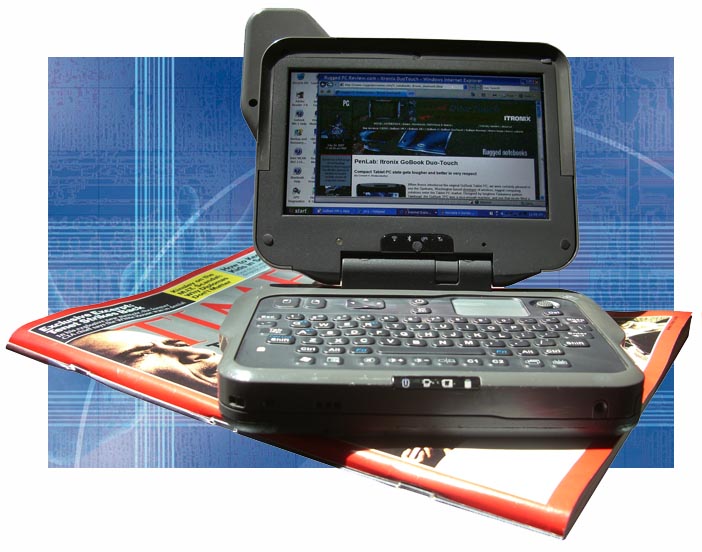 That should come as no surprise as the GoBook MR-1's origin lies in General Dynamics Itronix's resolve to creating a small form factor computer for industrial, governmental and military applications. The goals were lofty: produce a pocketable, wearable "warfighter" computer that's fully rugged, usable by Special Forces, homeland security and all branches of the military. And make it so that it could also be connected to a helmet display, pass MIL-STF testing, be upgradeable to Vista, accommodate all the latest wireless voice and data services, and protect data as securely as a bank vault.
That should come as no surprise as the GoBook MR-1's origin lies in General Dynamics Itronix's resolve to creating a small form factor computer for industrial, governmental and military applications. The goals were lofty: produce a pocketable, wearable "warfighter" computer that's fully rugged, usable by Special Forces, homeland security and all branches of the military. And make it so that it could also be connected to a helmet display, pass MIL-STF testing, be upgradeable to Vista, accommodate all the latest wireless voice and data services, and protect data as securely as a bank vault.
If the GoBook MR-1 looks somehow familiar, that's because it shares some DNA with the FlipStart micro PC. However, the GoBook MR-1 is much more than just a ruggedized version of the FlipStart. One look at the specs shows that General Dynamics Itronix began with an early concept and then added a whole lot of performance, shock-mounted components and wireless connectivity that is not available in the FlipStart, in addition to ruggedness, durability and a three-year warranty.
Technology
The picture below to the right shows the new GoBook MR-1 leaning against the already GoBook XR-1 rugged laptop. It illustrates just how small this technological marvel is.
We've seen a good number of attempts at very small Windows machines. Making one is a formidable challenge just from a packaging and miniaturization aspect. Worse, customers expect long battery life to go with a "PDA-size" computer. And that isn't easy when that same computer should also run Windows as quickly as a standard notebook. 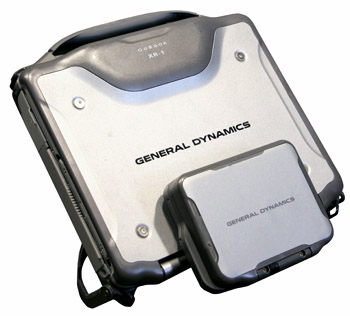 That is a tall order, and the reason why designers of micro PCs, and also of the earliest Tablet PC slates, often looked to alternate processor technologies, such as the now departed Transmeta Crusoe, chips from VIA, and lesser Intel offerings. The problem was always the same. While customers appreciated the slight increases in battery life, they deemed performance unacceptable, and almost invariably, the product either died or was upgraded to a "real" Intel processor, and larger size.
That is a tall order, and the reason why designers of micro PCs, and also of the earliest Tablet PC slates, often looked to alternate processor technologies, such as the now departed Transmeta Crusoe, chips from VIA, and lesser Intel offerings. The problem was always the same. While customers appreciated the slight increases in battery life, they deemed performance unacceptable, and almost invariably, the product either died or was upgraded to a "real" Intel processor, and larger size.
General Dynamics Itronix did not fall into this trap and equipped the GoBook MR-1 with a proper processor from the get-go. Proper, of course, is relative. The latest Intel chips are Intel64-based Core 2 Duos that support such things as high definition video, 802.11n wireless and other advanced technologies. That is not necessary for a machine like the MR-1. General Dynamics Itronix picked a 1.2GHz U1400 Ultra Low Voltage Core Solo, a very efficient processor with one operational computing core, a 533MHz frontside bus that draws just 5.5 watts of power as opposed to 27 for the higher speed standard Core Solos. The corresponding Ultra Low Voltage Core Duo chip, the U2500, would already consume 9 watts, and the speedier 667 frontside bus models several times that. Which means that the Core Solo chip is perfectly suited to the MR-1. It is also powerful enough. In our testing, which consisted of a good workout and everyday use of various programs and applications, it never displayed any of the lag that plagued earlier attempts at micro PCs; pretty much everything happens instantly. That is one of the most gratifying aspects of the MR-1 -- it's as quick or quicker than many full-size laptops.
Standard memory is 512MB of DDR2 DRAM, upgradeable to 1GB. The disk is a 40GB 1.8-inch Toshiba, described in more detail below. An 80Gb disk is available via a stackable expansion module (more on that concept later also). A hard disk heater is standard, and customers can order the MR-1 with a 16 or 32GB solid state hard disk instead.
Below you can see the General Dynamics Itronix GoBook MR-1 from all sides. The production unit plastic will likely have a somewhat different texturing, but all else is final. It's a clean, functional device that fits right into the new General Dynamics Itronix design language that unifies the entire lineup under the prestigious "General Dynamics" brand and portrays a sophisticated high-tech image.
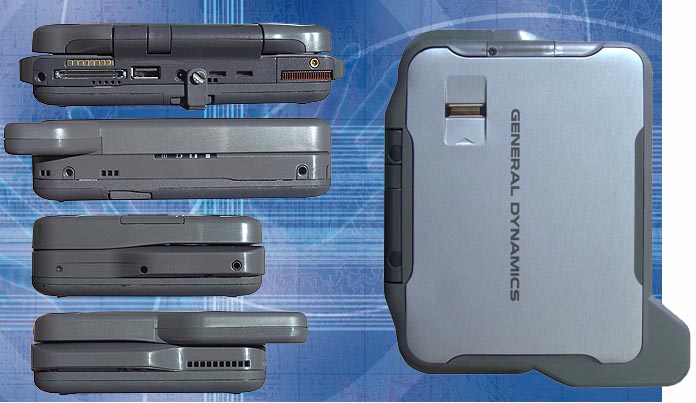
Wireless
Offering a wide variety of wireless options and flawless wireless performance has always been high on Itronix's priority list, and the tradition continues with the GoBook MR-1. As improbable as it seems given the tiny form factor, the GoBook MR-1 can simultaneously have and use four integrated radios -- three wireless RF modems and a GPS receiver. For wireless LAN, there is the Intel PRO/Wireless 3945ABG module. For wireless WAN, there are various GSM/EDGE/UMTS/HSDPA or CDMA/1xRTT/EV-DO options, depending on speed requirements and the wireless carrier of the customer's choice. Wireless PAN (Personal Area Network) refers to Bluetooth V.2 Class II which is also optionally available.
The GoBook MR-1 has several embedded antennas. They offer exceptionally good reception, but also add some bulk via the sizeable antenna bulge on the upper left side of the display. There is also a connector on the backside of the GoBook MR-1 for an external antenna.
Stunning Display
Running all of Windows on a very small screen is always a challenge. Today's applications simply take a lot of room. Web pages are designed to fit on high resolution screens, and we've become used to working with multiple windows and applications open. In the mid to late 1990s several manufacturers offered Windows CE-based clamshells with 640 x 200 pixel "wide" screens. Between the meager performance of those machines and the clipped functionality of early versions of Windows CE, you didn't get much, and buyers stayed away.
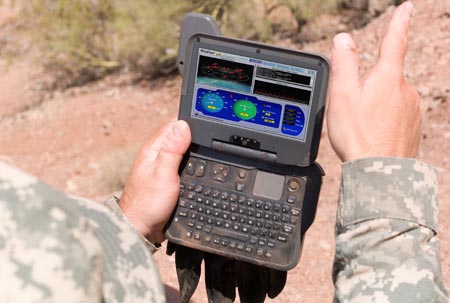 Now compare all that with the GoBook MR-1's display. It measures 5.6 inches diagonally, which means it is a small, wide-format 4.8 x 2.2 rectangle. But now look at the resolution. 1024 x 600 pixels! That is almost as much as the standard XGA 1024 x 768 found on notebooks with 12 and 14 inch screens, and even some 15s! What does that mean? The original Macintosh dazzled everyone with its high resolution screen that displayed 72 dots per inch. A modern garden variety notebook with a 1280 x 800 widescreen musters up 108 dots per inch. The 1400 x 1050 Toshiba screen we love so much for its sharpness has 145 dots per inch. But none come close to Hewlett Packard's late iPAQ 4700 Pocket PC with its totally stunning 203 dots per inch that made for a perfect, totally paperlike display. But even it cannot match the GoBook MR-1's screen that has a mind-boggling 213 dots per inch. This is easily the best and sharpest display I have seen to date. Now compare all that with the GoBook MR-1's display. It measures 5.6 inches diagonally, which means it is a small, wide-format 4.8 x 2.2 rectangle. But now look at the resolution. 1024 x 600 pixels! That is almost as much as the standard XGA 1024 x 768 found on notebooks with 12 and 14 inch screens, and even some 15s! What does that mean? The original Macintosh dazzled everyone with its high resolution screen that displayed 72 dots per inch. A modern garden variety notebook with a 1280 x 800 widescreen musters up 108 dots per inch. The 1400 x 1050 Toshiba screen we love so much for its sharpness has 145 dots per inch. But none come close to Hewlett Packard's late iPAQ 4700 Pocket PC with its totally stunning 203 dots per inch that made for a perfect, totally paperlike display. But even it cannot match the GoBook MR-1's screen that has a mind-boggling 213 dots per inch. This is easily the best and sharpest display I have seen to date.
To put it in perspective, the stunning resolution of the GoBook MR-1 means not only a sensational viewing experience, but also the ability to see just about as much as one can see on a standard notebook. Bring up a website designed for a standard 1024-wide display. It neatly fits onto the MR-1 display. No horizontal scrolling at all. Yes, vertically you get a bit less, but that's hardly noticeable.
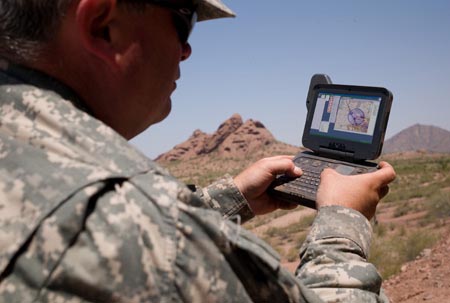 It's one thing to have extremely high resolution, it's quite another to convert that into a display where things don't look microscopic. This is where perfect sharpness, perfect stability and that difficult-to-describe "rock solid feel" come into play. You know it when you see it, and the MR-1 display definitely has it. Yes, the text and icons are all tiny as Windows XP isn't capable of elegantly adapting to extreme screen sizes. But the display is so crisp and sharp, you have to see it to believe it. Colors are as vibrant as it gets. Anything displayed on the screen looks as if it were printed on high quality paper. It's one thing to have extremely high resolution, it's quite another to convert that into a display where things don't look microscopic. This is where perfect sharpness, perfect stability and that difficult-to-describe "rock solid feel" come into play. You know it when you see it, and the MR-1 display definitely has it. Yes, the text and icons are all tiny as Windows XP isn't capable of elegantly adapting to extreme screen sizes. But the display is so crisp and sharp, you have to see it to believe it. Colors are as vibrant as it gets. Anything displayed on the screen looks as if it were printed on high quality paper.
What's almost equally amazing is how the display quality holds up under different lighting conditions. Most transmissive LCDs look great in dimly lit rooms and immediately start washing out in brighter light. Not the MR-1's. It remains jewel-bright in very well lit rooms, and even if you take it outside into the shade. In bright sunlight it still remains readable thanks to General Dynamics-Itronix's matchless DynaVue display technology (see related article on DynaVue technology) that combines anti-reflective coating with a circular polarizer. Of course, no LCD display can compete with direct sunlight in terms of brightness. Instead, the display needs to reduce as much as possible the light reflected back in order to preserve as much contrast as possible. That's what DynaVue does, and the result is that you can still see the display in direct sunlight. It is no longer as bright and brilliant, of course, but you can still see it. The two military pictures above exaggerate direct sunlight viewability a bit, in my opinion, but not by much. What happens in direct sunlight is that the picture is still there and has decent contrast, but it now looks like that of a reflective LCD as opposed to having the vibrancy of a transmissive display indoors.
The remarkable thing here is that the GoBook MR-1's stunning screen performance is achieved with a transmissive rather than a transflective or reflective display. The latter two are compromises that improve direct sunlight readability but the price is a significantly dimmer, murkier picture indoors.
Oh, and the display has a heater. Standard.
Zoom
So the GoBook MR-1 display is second-to-none indoors and even outdoors in the shade and remains readable in direct sunlight. But what if you run into a situation where the text is simply too small to read comfortably? Well, they thought of that and added "Zoom," a software utility that toggles back and forth between native and magnified display. There is a special "zoom" button with a little magnifying glass on it. It sits next to the Windows button. "Zoom" affects only the window you're working on, a smart choice. You are also supposed to be able to increase or decrease the magnification level by continuing to hold the Zoom key and then use the jog dial to zoom in and out until a comfortable zoom level has been reached. The jog dial, however, is one function that the original FlipStart device has, but we have not been able to find on the GoBook MR-1.
Port Replicator
Very small computers like the GoBook MR-1 cannot possibly accommodate all the full-size ports and connectors that fit onto a standard notebook computer. That is where "port replicators" come into play. You generally snap them onto the back of a device and that is the approach General Dynamics took with the MR-1.
The replicator measures 6.2 x 1.875 x 0.75 inches and adds standard jacks for audio in and out, RJ45 LAN, 9-pin serial, two USB 2.0, and a standard 15-pin VGA video-out port. It's small enough to be taken along, and it is very nicely integrated into the overall design of the GoBook MR-1. A vehicle dock is also available for vehicle mount applications.

Keyboard
Keyboards are the bane of the existence of small device designers. That's because keyboards are perhaps the biggest anachronism in all of computing. I mean, what other part of a computer has its origins in some arbitrary layout designed to slow down typists of mid-19th mechanical typewriters? Yet that is what we have to work with, and human nature being what it is, once someone has learned the dreaded QWERTY layout, it seems impossible to erase it from their brains. Numerous approaches have been tried, all sorts of alternates -- handwriting recognition, gestures, character recognition, tiny onscreen keyboards, alternate layouts optimized for small devices -- yet nothing really worked. Millions are using the predictive "T9" approach from Tegic to tap out SMS messages on cellphones, and before that, millions used Graffiti to conjure up characters on the screen of Palm Pilots.
With the GoBook MR-1, General Dynamics-Itronix's designers went with what one might call a "hybrid" approach. They had significantly more real estate to work with than PDA and smartphone designers, but not enough to make a useful standard keyboard, so they decided to come up with a backlit, sealed 76-key layout that could be used both in "thumbtype" mode and in standard notebook mode. In "thumbtype" mode you hold the device in both hands, with your thumbs on the keyboard. RIM pioneered this with its Blackberrys. Everyone laughed about it initially, but it worked. Somehow, typing on a small device with both thumbs seems to make ergonomic sense. However, it is an approach that appears to work best with comparatively tiny keyboards such as those found on Blackberrys and now numerous other smartphones and the like. So the GoBook MR-1's extra real estate didn't offer any advantages in that respect because a wider thumbtype keyboard is not necessarily a better one. However, for regular notebook-style typing, larger is always better, and the closer you get to a standard full-size touchtype keyboard, the better. That's because our fingers simply know where to find the keys.
The MR-1's designers came up with a compromise. The GoBook MR-1 keyboard is 50%-scale as opposed to the Blackberry/smartphone thumbtype keyboards that are usually in the 24-28% scale range. That makes sense. Looking at the layout, they actually could have squeezed in a 65%-scale QWERTY layout, but that simply would have made it harder for thumb-typing without getting noticeably closer to actual touch-typing. As you can see below, keys, touchpad, navigation disk and moue buttons all lay within easy reach of your thumbs. And the image dramatically shows just how small the device is.
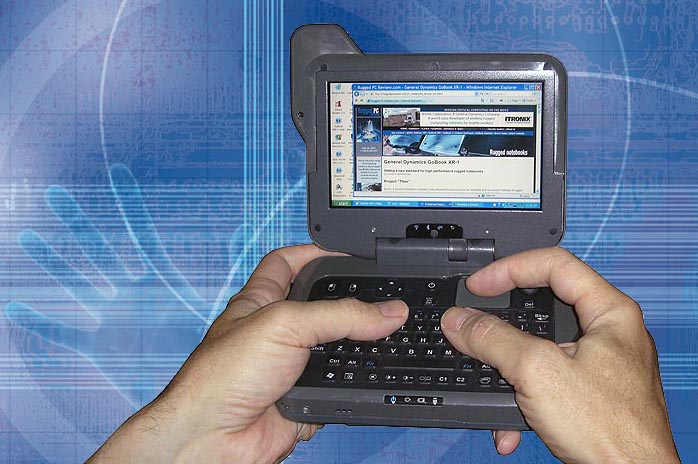
The keys, likewise, are a compromise. They had to work right for thumb-typing where it is important for the relatively large thumbs to be able to differentiate one from the other, they had to be large enough to work for conventional typing and also provide the ever-important tactile feedback, and they had to provide proper sealing and ruggedness.
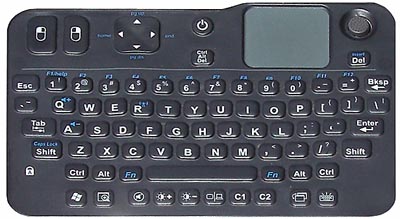 Further, since this is a full-function computer and not a smartphone or PDA, the keyboard had to include much more than just the QWERTY and punctuation keys. So we're not only finding the typical Esc, Ctrl, Alt, Del keys, but also a whole row of special keys. There's the Windows key that brings up the start menu, the zoom key, a mute key, screen brightness up and down keys (oddly up to the left and down to the right, opposite from what one expects or what is shown in the brightness bar on the screen), one that switches between onboard and external display, two programmable application launch keys labeled C1 and C2, one that brings to the foreground whatever window the cursor is on, and one that illuminates the keyboard. Further, since this is a full-function computer and not a smartphone or PDA, the keyboard had to include much more than just the QWERTY and punctuation keys. So we're not only finding the typical Esc, Ctrl, Alt, Del keys, but also a whole row of special keys. There's the Windows key that brings up the start menu, the zoom key, a mute key, screen brightness up and down keys (oddly up to the left and down to the right, opposite from what one expects or what is shown in the brightness bar on the screen), one that switches between onboard and external display, two programmable application launch keys labeled C1 and C2, one that brings to the foreground whatever window the cursor is on, and one that illuminates the keyboard.
There are also two blue-labeled function keys flanking the space bar. They provide access to the 12 function keys as well as a few extra functions on certain keys. Those are kept to a minimum, and as a result, all keys are clearly labeled with large white letters and symbols, which makes the very readable (as opposed to some tiny smartphone keys that have two or three symbols on them).
Navigation is another issue where a compromise between thumbtype operation and notebook operation had to be reached. Itronix came up with a very workable solution. All navigational controls are above the keyboard. To the left are left and right mouse keys and a four-way navigational disk that represents the standard four directional keys and, with the function key, even allow page-up, page-down, home, and end. On the right side are both a nicely sized touchpad and a touch stick. Overall, this arrangement works perfectly for thumb-typing and requires a bit of getting used to when using the MR-1 as a notebook. The choice between using the touchpad or the touch stick will come down to personal preference. For desktop use, of course, you can always plug in a mouse. And there's yet another navigation option: Itronix also offers the MR-1 with a touchscreen, and not just any touchscreen; it is one that takes full advantage of the DynaVue technology, offering a brighter picture outdoors than has been thought possible.
Power
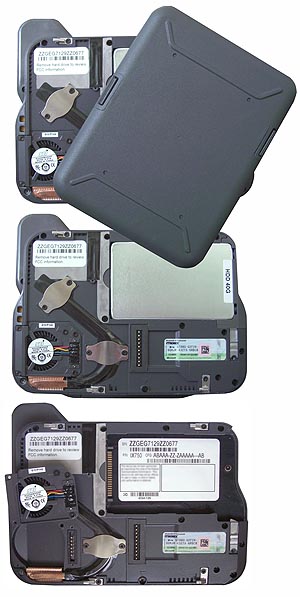 The MR-1's battery snaps onto the bottom of the device. It is actually an integral part of the design, sitting in a magnesium shell, and adds a bit of thickness to the overall housing. Our original review unit came with a 29 watt-hour capacity battery whose flatness suggested Lithium-Polymer technology but was, in fact, Lithium-Ion. The battery snaps onto four sturdy metal hooks. To remove it, you depress two levers, then glide the battery to one side. The picture on the right shows the battery undone and sitting on top of the computer's system unit. The MR-1's battery snaps onto the bottom of the device. It is actually an integral part of the design, sitting in a magnesium shell, and adds a bit of thickness to the overall housing. Our original review unit came with a 29 watt-hour capacity battery whose flatness suggested Lithium-Polymer technology but was, in fact, Lithium-Ion. The battery snaps onto four sturdy metal hooks. To remove it, you depress two levers, then glide the battery to one side. The picture on the right shows the battery undone and sitting on top of the computer's system unit.
GD-Itronix is now shipping the MR-1 with an extended 8,000 mAh pack. That's twice the capacity of the original battery, almost 60 watt-hours. It is thicker, about 0.6 inches compared to the original slice that was 0.3 inches, but that is a more than acceptable trade-off for much longer battery life. The original, smaller battery provided about three hours, the extended one more than six hours. Our battery draw-down benchmarks also suggested over six hours.
Thermal engineering and cooling
The General Dynamics-Itronix thermal engineers are absolute wizards. I have seen them in action at the Itronix plant in Spokane. Modern technology generates heat, and that heat must be managed, distributed and dissipated. Even though the sturdy magnesium chassis of the GoBook MR-1 is a good heat sink in itself, the rather powerful Intel processor and other components still need sophisticated thermal management.
To that extent, the MR-1 has a small 1.25-inch diameter fan that draws just over a watt of power when it operates. Look at the middle picture in the series to the right. The fan, at the bottom left, is a thing of beauty, but the way it's integrated into the MR-1 is even better. It sits inside the housing, but in its own compartment that is totally sealed towards the electronics. The bottom picture shows the fan unit remove and just sitting on top of its bay so you can see the sealed connector.
The power connector has its own rubber O-ring seal. When the fan operates, it circulates cool outside air through a copper radiator-like heat exchanger that is attached to a copper thermal guide. So heat is essentially collected from the hot spots inside the device and then safely channeled to the fan where it is disposed. The little fan is easily replaceable, so should it ever break it's a five minute job to put in a new one. And I am certain, the Itronix engineers used numerous sensors to track internal heat and its dissipation under numerous operating conditions and then tweaked everything for maximum thermal efficiency. They do that.
Ruggedness and Protection
As you might guess, space is at an absolute premium in a device such as the GoBook MR-1. Which means that Itronix's engineers had to come up with a lot of space-saving solutions without giving up ruggedness or thermal management.
The slimline 1.8-inch ATA-100 60GB 4200rpm Toshiba HDD1682 hard disk, for example, has its own precision-crafted rubber frame that then neatly and very tightly fits into a metal enclosure that is just a quarter of an inch thick. The disk therefore is both shock- and impact-protected. That is precision engineering at its very best. The disk slides into the chassis and sits there tightly wedges, never rattling around. The disk is further held in place by a sturdy metal latch that grabs onto a trim piece that, in turn, is held in place with two screws.
As far as environmental protection, sealing and ruggedness testing goes, General Dynamics Itronix positions the MR-1 at approximately the same level as the larger XR-1 in terms of drop, vibration, rain, dust and temperature resistance (hard disk heating is standard). Testing is in accordance with MIL-STD 810F, both inhouse and at external independent testing labs. An IP54 ingress protection rating means the MR-1 is is protected against dust and also against water spray from all directions.
The "Slice" expansion system
Above I explained how the battery simply slides onto the bottom of the MR-1, becoming an integral part of it. Likewise, MR-1 customers will be able to order expansion "slices" that reside between the computer and the battery. A factory-installable "legacy" slice adds a second USB port, a 9-pin RS232 port, and TPM. Other expansion "slices" are being considered. They include one with a Type II Cardbus slot, one with various Telco modems, one with MIL-STD radios, Smart Card, a 2D imager or the like, and so on. Thee possibilities are endless.
How will such "slices" fit into the fully ruggedized and sealed design of the MR-1? Well, by being sealed themselves, and by using rubber dust covers and plugs wherever necessary.
Expansion is also possible in other ways. The top of our device, for example, contained a UPEK swipe-style fingerprint scanner. There are some limitations in that area. You can have the fingerprint scanner or Bluetooth or the touch screen option, but just one at a time.
The MR-1 having started life on a military commission, it does not surprise that General Dynamics Itronix considers future expansions such as wearable peripherals, night vision goggle compatibility and other warfighter gear. But the company also plans on offering less exotic gear such as vehicle power, USB optical and hard drives, cameras, and RFID scanners.
Security
The GoBook MR-1 implements a number of security functions. The integrated fingerprint scanner provides biometric access protection. There are several levels of passwords, at the pre-boot, supervisor, and user levels. There is also configurable access to all input/output devices for data transfer restriction and multiple asset protection features. The device can be set to boot in stealth mode without any lights and sounds. And though a Trusted Platform Module security chip is not built in, it is available as part of the legacy stackable expansion module. As stated above, the hard disk is firmly held in place and cannot simply be snuck out. The biggest problem may be the MR-1's size itself. It's so small that it can easily get lost, or stolen. So keep an eye on it!
Not your average clamshell UMPC
Earlier I pointed out that the GoBook MR-1 shares some of its origins with a consumer product, the FlipStart. That is not a bad pedigree as the FlipStart was backed by none other than Microsoft co-founder Paul Allen and has received a lot of publicity.
However, the FlipStart was designed as a consumer product whereas the GoBook MR-1 was developed from the start with the needs and requirements of government as well as commercial and industrial markets in mind. The MR-1 meets or exceeds military standard 810F for drop, shock, vibration and temperature, and has an impressive IP54 ingress protection rating for humidity, water, dust and spillage. The FlipStart, as a consumer-grade device, cannot match any of that. For some reason, the FlipStart still uses an old 1.1GHz Pentium M chip whereas General Dynamics Itronix chose the new and much more powerful yet energy-efficient 1.2GHz Intel Core Solo processor. The MR-1 comes with a 40GB disk and has 80GB hard disk and solid state disk options; the FlipStart is limited to its a 30GB disk and its 512MB of memory is not upgradeable. The MR-1 can accommodate 1GB of RAM with its dual slot configuration and is available with a touchscreen and uses the DynaVue display technology that is as good as it gets and makes the computer usable under all lighting conditions. You can't get a touchscreen with the FlipStart, and its display lacks the DynaVue treatment, which means it's primarily for indoors.
The GoBook MR-1 offers "slice" expansion modules whereas the FlipStart cannot accommodate additional functionality. And while the FlipStart has 802.11b/g WiFi, Bluetooth and is Sprint Mobile Broadband ready, the MR-1, in addition to Bluetooth, has the Intel PRO/Wireless 3945ABG module for WiFi, a whole variety of 3G wireless options and embedded GPS. On the security front, the MR-1 has a fingerprint scanner and can be equipped with TPM 1.2. The FlipStart has neither and it also cannot come near the MR-1's battery life. Then there are warranty and service. The MR-1 has a standard 3-year warranty with a Mobile Help Desk as well as a variety of comprehensive service level options for enterprise customers.
General Dynamics Itronix took the FlipStart concept as a basis, but that is where the functional similarity between the currently available products ends. The GoBook MR-1 evolved not only into a vastly more durable and rugged device, but also a more modern, more powerful computer.
Summary
With the GoBook MR-1 General Dynamics Itronix set out to provide a pocketable and wearable rugged device that's able to run Windows XP, Windows Vista down the line, and provide essentially all the functionality and power of a standard notebook computer. They succeeded admirably and at every level. During the entire review process we were looking for compromises and weaknesses that would seem unavoidable when packing so much functionality into such a small device. We were even prepared to accepts such compromises and shortcomings.

Yet, we found none. There are none of the quirks and annoyances usually found on miniature computers. The General Dynamics Itronix is for real. It is a "real" computer, just one that's a whole lot smaller. That can make a huge difference in situations where size and bulk matter, yet where a small Palm or Windows Mobile device just won't do. The MR-1's size, power and flexibility mean it can provide full computing and communications power where none was possible before. It can be carried in pockets, invisibly mounted in small spaces, or hooked up to a full keyboard and big screen when in the office. And it does all that while being as tough and rugged as any other General Dynamics Itronix computer. It won't only be the military that'll be interested in this remarkably competent machine.
General Dynamics Itronix MR-1 highlights:
- Fully rugged pocket computer in a tiny package
- Superb outdoor-viewable hi-res display
- Versatile, easy-to-use thumb-type/standard-type keyboard
- Full notebook functionality
- Four simultaneous internal radios possible, including GPS
- Stackable expansion modules do not affect small footprint
- Same ruggedness as much larger XR-1
But keep in mind:
- Small keyboard requires some getting used to
- Smaller size doesn't mean smaller price
- Some desirable options are "either/or"
– Conrad H. Blickenstorfer
General Dynamics Itronix MR-1 Specs
| Added/changed |
Added 6/05/2007; updated 12/15/2008
|
| Type |
Fully rugged pocket notebook
|
| Processor |
Intel Core Solo U1400 1.20GHz, 533MHz FSB |
| OS |
Windows XP Professional; Windows Vista capable |
| Graphics Controller |
Intel Extreme Graphics |
| Memory |
1GMB 533MHz DDR2 expandable to 4GB (2 slots) |
| Display |
Outdoor-viewable 5.6" WSVGA (1024 x 600) TFT with DynaVue Technology (Meets DOD-STD-3009 military standard for cockpit displays for viewability and ambient light ratio). Optional touchscreen |
| Digitizer/Pens |
Optional touchscreen with DynaVue Touchscreen technology/1 |
| Keyboard |
76-key sealed 50%-scale backlit |
| Storage |
60GB heated and shock-mounted 1.8-inch 4200rpm (80GB via stack-mountable expansion); 32 or 64GB solid state HDD optional |
| Stackable expansion modules |
Options: USB + RS232; Type II Cardbus, telcom modems, MIL-STD radios, Smartcard |
| Slots |
none |
| Housing |
Magnesium chassis |
| Operating temperature |
-10 to 140 degrees Fahrenheit |
| Vibration/Drops |
Tested according to MIL-STD-810F 514.5 C-17 & C-18 (vibration) and 516.5 (26 3-foot drops) |
| Enclosure Class |
IP54; "exceeds MIL-STD 810F 506.4" |
| Hazardous materials |
compliant with Hazardous Locations (HazLoc) UL1604 Class I, Division 2, Group A, B, C & D |
| Size |
6.6 x 4.8 x 1.6" |
| Weight |
2.4 pounds with extended battery pack |
| Power |
8,000mAH (59 watt-hour) extended battery ("6 hours") |
| Communication |
Intel PRO/Wireless 3945ABG; Optional: Bluetooth, GPS, 1xRTT/EV-DO or EDGE/UMTS/HSDPA |
| Interface |
1 USB 2.0, port replicator, fingerprint scanner, external antenna; via port replicator: RS232, 2 USB 2.0, VGA, RJ45 LAN, audio in/out; legacy ports available through "slice" expansion modules |
Price |
Base configuration starts at US$4,450 |
| Contact |
General Dynamics Itronix www.General Dynamics Itronix.com or 1-800-441-1309 |
|



